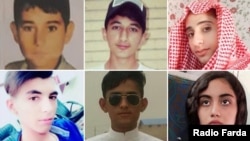Radio Farda's investigations confirm that the number of underage victims of recent protests in Iran has risen to eighteen.
However, more than two weeks after the demonstrations the Islamic Republic authorities have not yet declared the exact number of those killed during the four-day rallies that shook the clergy-dominated country.
Reports received by human rights watchdogs and civil rights activists maintain that the security forces killed more than twenty under-eighteen-year old persons in bloody attacks on protesters.
The identity of eighteen out of the twenty victims has so far been confirmed, independent human rights organizations say.
Eight of the adolescents were killed in the oil-rich province of Khuzestan, where anti-Islamic Republic protests were intense. Meanwhile, the provinces of Alborz, Isfahan, Kermanshah, and Tehran also lost two juveniles each.
A pro-reform Tehran legislator, Ms. Parvaneh Salahshouri had earlier confirmed that there had been children among the people killed in the crackdown on protesters, but she stopped short of mentioning the number of underage victims of the deadliest uprising in the four-decade history of the Islamic Republic.
The case of a fourteen-year-old victim, Nikta Esfandani, has been singled out in recent days.
She was shot dead by a single bullet in the head on November 16, in Sattar Khan neighborhood of Tehran. Nikta's family searched for her for three days before they could receive her body.
"Regime's officials told her family that since she was only 14 and was a kid, they would not ask for the cost of bullets. Born in April 2005, she was buried in Behesht-e Zahra cemetery on November 20, 2019," Iran Human Rights Monitor (IHRM) reported on November 29.
The young victim's family said on their loved one's Instagram page that they hoped Nikta's murderer(s) would not get away with the crime.
Nikta had more than 2,000 followers on Instagram when she was gunned down in Tehran.
Nevertheless, the spokesman of the Islamic Republic Judiciary, Gholam Hossein Esmaeili, had earlier claimed that Nikta had died of poisoning, and her death had got nothing to do with the protests.
Responding to the claim, many social media users have insisted that if that was the case, an independent medical team should investigate and decide the cause of death by a simple autopsy.





